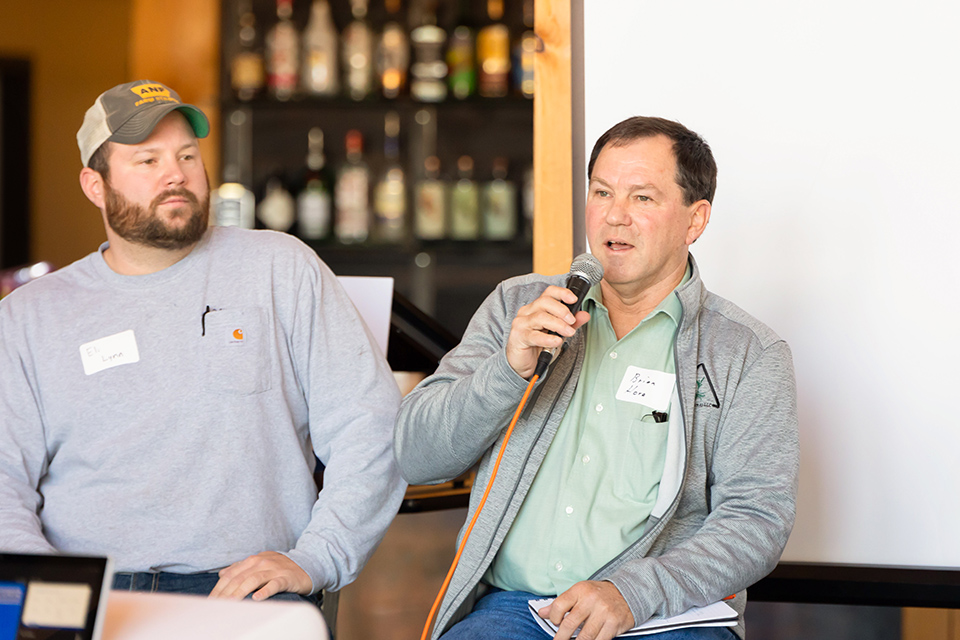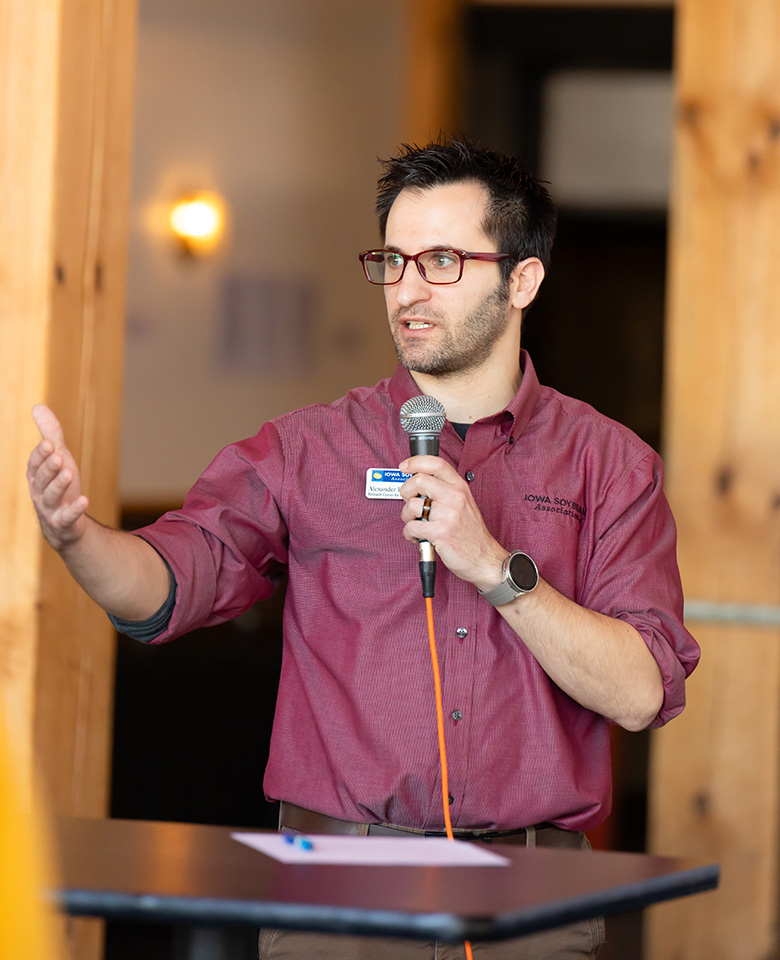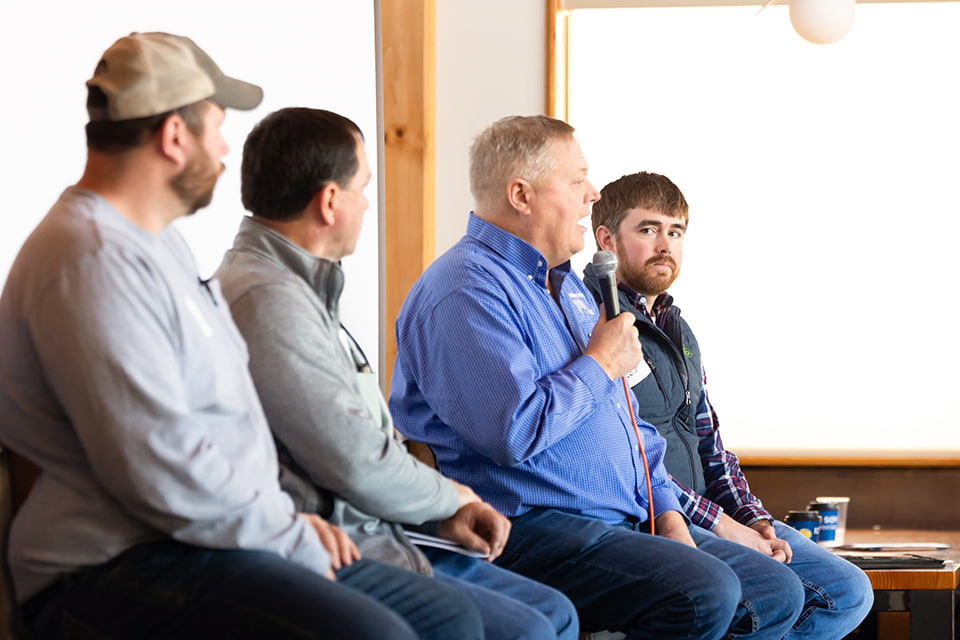
(Photo: Iowa Soybean Association / Joclyn Bushman)
Farmers taking an active role in research
February 15, 2024
For those who attended Iowa Soybean Association’s (ISA) Innovation to Profit event in Fairfield earlier this month, the message was direct – create a better environment for soybean farmers.
Dr. Alexander Litvin, the research agronomy lead with ISA’s Research Center for Farming Innovation (RCFI) says ISA’s goal is to bring value to the farm for its farmer-members and all soybean producers in the state.
“We want to be good stewards of the land and make sure our farmland is still there and fertile for future generations,” he says. “We want to improve productivity, profitability and sustainability – by bringing these three things together, it’s a win-win-win.”
What are your needs?
RCFI research is designed to focus on individual farmers and their specific needs, Litvin says. What works on one farm does not necessarily translate to another farm.
“Fields are different,” he says. “We want to make sure the research works for your farm.”
Litvin says collaboration with farmers across the state is helping RCFI determine what is working and gathering data to highlight those results to producers in every corner of Iowa.
“What we do is completely based on what you are doing,” he says. “Technology, data and trials are important. We want to find out if this is the way forward or not.”
Those trials include seeding rates, conservation methods, fertilizer use, timing, weather information and the overall return on investment (ROI).
“If you plant more, you get more, right?” Litvin queried. “There’s only so much space where you plant. Seed costs continue to rise, so if you’re putting out more, you want to make sure your yields reflect that.”
Litvin says after a farmer incorporates seed costs and other input expenses, finding the maximum ROI before it plateaus or drops off is critical. That’s why RCFI continues to gather data and key information so participating farmers can discover what works best for them.
“There are multiple aspects to how we plant,” he says. “We want to maximize your ROI.
“For every pressure, we work to better figure out the specifics – rainfall, soil type, fertilizer application. How can we improve those numbers?”
Nitrogen application is one example of conducting trials to see if a farmer is applying too little or too much to his or her fields.
“If you’re paying for nitrogen, you want to make sure you’re getting value out of it,” Litvin says. “The rates vary widely across the state and from field to field.”
Individualized information and data helps farmers secure the highest returns with the lowest input costs, while also protecting the environment.
“The best way to find out about what works for your fields is to partner with ISA,” Litvin says.
A farmer perspective
Four southeast Iowa farmers shared their experiences with cover crops and other conservation practices during a panel discussion.
Eli Lynn, who farms in Jefferson and Van Buren counties, conceded starting out with cover crops four years ago wasn’t easy.
“In the beginning, it did not go very well,” he says. “Figuring out the timing and trying to work that out was a challenge.”
But in time, through trial and error, Lynn says things are better. He’s also changed how he applies chemicals and nutrients such as using liquid NPK fertilizers with a liquid applicator, allowing for rapid nutrient uptake when dealing with nutrient deficiencies or providing a quick boost during critical growth stages.
Brian Hora from Washington County began his cover crop journey more than a decade ago, planting soybeans into rye.
Over the years, he says watching the results through soil sampling practices and examining every field, the changes have been significant in terms of soil quality and improved nitrogen levels and nutrient release.
Hora says he’s also following the information about carbon intensity numbers and how that could help farmers with their production.
“Right now, carbon programs are difficult to understand,” he says. “We all have to figure out what we’re facing.
“With carbon and biofuels, it could be a massive opportunity. We’re waiting to see what the IRS rules will be in March. It looks like there’s tremendous value - not in the short term, but in the long term.”
Hora believes it may be an opportunity for farmers to capitalize and says “it’s an opportunity that we need to be aware of.”
Meanwhile, Michael Fosdick in Mediapolis began farming corn and soybeans in 2014 and began using cover crops two years later.
He says he’s using rye and radish in his fields but noted that the process has been slow.
“It’s about taking baby steps,” Fosdick says.

John Maxwell, who farms 4,000 acres of soybeans and corn in Scott County, has facilitated cover crops since 1984, beginning with kale and now focused on winter-hearty cereal rye.
“I believe in planting early,” he says. “We have very high production ground, so I have to get my planting done early. Herbicides generally don’t work until it’s 50 degrees, and then I use some of it.”
Maxwell, who also raises cattle, uses manure on his acres.
“It’s been a huge difference in my bottom line, and I’m committed to using manure as my source of fertilizer,” he says, acknowledging he will spoon feed nitrogen to his corn crop if necessary.
Maxwell says he’s also data driven and having that information drives decisions about what to plant, when to plant, fertilizer application, adjusting for weather and more.
“The key to higher yields is keeping the crop the greenest the longest,” he says. "The analysis and data will make you money or help save you money.”
Maxwell says conservation practices like cover crops are important because eventually that will become the standard practice and dictated by the government.
“My challenge to you is that you have to tell your story. Europe failed to do that,” he says. “Because Europeans didn’t tell their story, now they’re told what to plant, where to plant, how to plant – everything is government run.
“Please tell your story. It’s vitally important to every single one of us.”
Litvin says much of what RCFI and farmers are doing now is staying ahead of regulators.
“Speak to what you do, and learn from what each other is doing,” he says.
Opportunities available
ISA Conservation Agronomist Ben Porepp says soybean producers can get started on implementing conservation practices with help from ISA.
ISA helps farmers identify what they want to happen on their farm, look at the specifics and develop a solution for their sustainability goals.
“There are plenty of opportunities out there,” Porepp says. “We can help set you up with programs and go through best practices. Lean on us to help make sure you are profitable and sustainable.”
But implementing cover crops, for example, can be costly.
The good news, Porepp says, is that there are cost-share programs that can help cover costs or defray some of the expenses.
But because there are multiple options, he says it can be confusing.
“There’s a huge influence of dollars coming in,” Porepp says, adding that funding distributed through numerous agencies and figuring out what a farmer needs to do can be quite heady.
Porepp pointed to the Farmers for Soil Health program that allows farmers to earn up to $50 per acre that facilitate cover crops and can be stacked on top of existing federal funding initiatives.
“It’s a little more bang for your buck,” he says, adding that the program does not require a binding contract.
Porepp also suggested programs like the Soil and Water Outcomes Fund (SWOF), which provides financial incentives directly to farmers who transition to on-farm conservation practices that yield positive environmental outcomes like carbon sequestration and water quality improvement.
“We want to connect farmers and landowners with these financial resources,” he says. “We want to see you be profitable.”
Outreach efforts by ISA conservation agronomists have yielded in many soybean farmers saving tens of thousands of dollars.
“That’s real dollars staying in your fields,” Porepp says.
Conservation practices
ISA Conservation Services Manager Brandon Iddings says ISA is also there to showcase and assist with conservation practices that can yield positive results for the wallet and the environment.
Iddings says beyond cover crops, there are edge-of-field practices and the use of saturated buffers, bioreactors, oxbow and wetlands restoration efforts that can make a difference.
Saturated buffers are designed to remove nitrates from agricultural tile water by modifying the outlet to allow flow to be diverted through the soil profile of a vegetated buffer.
Bioreactor refers to any manufactured device or system that supports a biologically active environment. In one case, a bioreactor is a vessel in which a chemical process is carried out involving organisms or biochemically active substances derived from such organisms.
Oxbow wetlands store excess water that might otherwise lead to flooding, filter water to improve water quality and provide habitat to a variety of wildlife. Over time, some oxbows fill in with sediment due to erosion of soil in surrounding areas.
There is also an emphasis on prairie strips, Iddings says, where vegetation is strategically integrated into row crops, designed to improve biodiversity and protect soil and water resources.
Iddings says ISA’s RCFI works with many partner organizations, like the Iowa Department of Natural Resources and others, to make these practices a reality.
For more information about RCFI and their services, click here.
Back